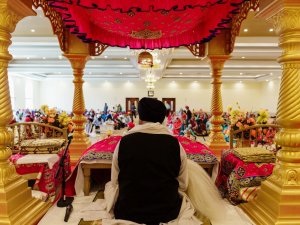Dr. Jaspreet Kaur and Santbir Singh uncover the parallels between Sikh oppression in Punjab, and Indigenous subjection on Turtle Island (currently North America). They highlight how women have been central in the struggle for land, water, and self-determination, and make a strong case for Sikhs supporting and standing in solidarity with Indigenous movements.
In April of 2016, young women from the Standing Rock Sioux Tribe brought attention to an issue that would change the world. Thirteen-year-old girls Tokata Iron Eyes and her friend Anna Lee Rain Yellowhammer, along with their friends, started a petition, a hashtag, held rallies, and organized a 2000 mile relay race to Washington D.C. to deliver their petition.
What came to be known as the #NoDAPL movement garnered international attention and is still being battled. The issue of water and land because tied to identity, the right to exist and environmental rights.
Almost a hundred year earlier, another young woman similarly stood up for her land in a move that would shape Sikh history and activism. In 1914 the British were designing New Delhi, their new capital for an empire that was to stand for a thousand years. Gurduara Rakab Ganj, where Guru Teghbahadur Sahib’s body had been so lovingly cremated, stood in the way of their carefully laid out roads. As the colonialists knocked down the wall of the Defender of Freedom, who had so boldly sacrificed his life for principle of freedom of choice, one solitary woman stood before the might of the world’s most powerful empire. Young Bibi Sham Kaur, a widow, lay down before the machines, her baby clutched to her chest. The British were astounded and the Sikh nation was awoken from a decades long slumber. The Gurduara Reform Movement was launched and it fed directly into the Independence Movement, which grew into Punjabi Suba Struggle and finally the Dharm Yudh Morcha and the struggle for Sikh Sovereignty.
Land and water have been a part of the Sikh identity from the inception of the faith. Guru Nanak Sahib writes in Asa ki Var (SGGS Ang 472) that water is the root of all life; it gives birth to all living things, including our very Panth. From Guru Nanak Sahib’s emergence from the waters at Sultanpur Lodhi to the creation of the Khalsa with the Gurbani, Patasa and Khanda infused Amrit of Guru Gobind Singh Sahib, water is the transformative medium through which a connection with Vahiguru is facilitated. We are a people spiritually born from water, who are replenished by Sarovars and Baoilis, and who come from Punjab, a land of grain, plentiful resources and of course water; Punjab literally meaning the Land of Five Rivers. To understand Punjab and its tumultuous history, you have to understand the water; it is connected to the rhythms of life, rights of religious passage, and the fight for Sikh sovereignty. Everything in Punjab can be traced back to it.
Over the last seventy years Sikhs, and in truth Punjabis of all backgrounds, have been victimized time and time again by the Indian government. The importance of water in Punjab was never beyond the understanding of the central government of India. The diversion of water out of Punjab and into neighbouring states occurred as a part of the Punjab Reorganization Act under Indira Gandhi’s government, are law that was part of the long term strategy of the Indian state to attack Sikhs at a number of levels, from undermining our religious institutions, destroying Punjabi culture and language, taking away our economic resources and removing entire parts of the Punjabi speaking homeland (already fractured from the 1947 Partition) from us. But more than anything it was the loss of control of our own rivers and environmental ecosystems was a blow so deep that even now, after fifty years, the wound is still raw to the Punjabi soul.
After decades of peaceful protests the Sikh nation created the Anandpur Sahib Resolution (ASR), an incredible consensus-based document that reached back to the core principles of Sikhi. Though it was labeled as a radical document by the Indian state and media, it would have given Punjab far fewer powers than Quebec enjoys today in Canada, or that any state in the US has or than the rights devolved to Scotland, Wales and Northern Ireland in the UK. What the ASR simply demanded was a democratic and equitable model of reorganization for India, where the rights of minorities (religious, cultural and linguistic) were protected and the Central government’s powers were partly decentralized to the states (in fields like education, resource development, etc). And of course, for Punjab to have control of it’s beloved rivers once more.
As the Panth had done since Bibi Sham Kaur so boldly blocked the British from their illegal takeover of sovereign Sikh land, a non-violent protest movement, the Dharam Yudh Morcha, was organized to push for the implementation of the ASR. The Indian state met these protests with increasingly horrific incidences of violence including of the massacres of innocent protesters (Amritsar Vasakhi Massacre of 1978, Kanpur Massacre of September 1978, Chando Kalan Massacre of 1981) , extrajudicial killings, organized sexual violence against Sikh women and girls and acts of unspeakable sacrilege against Guru Granth Sahib ji and Gurduaras. The trend of targeting Sikh women with state organized rape and sexual assault would only worsen with time, with Kaurs targeted during the November 1984 Pogroms and on an an almost unimaginable scale during the Punjab Police’s counter-insurgency abuses from 1986 to the early 1990s.
At this time of rising discrimination, a great leader of the Panth arose, Sant Jarnail Singh. It was to counter his fight for the implementation of the Anandpur Sahib Resolution, a demand for democratic rights, decentralization and rights over water, that the Government brutally attacked the heart of the Sikh nation in June 1984. And in the decade of genocide that followed the massacre of 10,000 Sikhs on the marble parkarma of Harmandir Sahib, the fight for water rights became intertwined with the struggle for Sikh sovereignty, as the Sikh nation realized it had no choice but to fight for it’s survival.
This should sound familiar. After centuries of oppression, which included everything from forced relocation, organized cultural and linguistic destruction, the stealing and systematic sexual assault of children, exploitation of resources and outright genocide, today Indigenous North Americans face issues like the Dakota Access Pipeline, the recently approved Canadian Kinder Morgan pipeline and the replacement of Enbridge’s Line 3, all of which threaten access to clean drinking water and will potentially compromise traditional hunting and fishing rights.
Beyond pipelines, First Nations across Canada have faced living conditions for decades that settler Canadians wouldn’t bear for even a few hours. As of November 2016, 130 First Nations were living under a boiling water advisory. (A boil-water advisory is a public health advisory given when a community’s drinking water is contaminated by pathogens, and must be boiled to increase its safety.) Everything from cooking, washing and drinking takes more thought than any of us in Canada’s cities would ever consider. While other Nations suffer the ill effects of industry on their sources of water, with decades of government promises constantly remaining broken.
The reasons that many of us in the Sikh diaspora are on the lands of Indigenous people vary, from seeking economic gain and education, to searching for freedom from an oppressive regime. We have settled into the fabric of these countries. We are educators, business people, politicians and artists. And now that we have established ourselves, we have used our social capital to talk about the violence we experienced and stressed the need for our new governments to ally with us against the Indian state in our struggle. And yet, what was once understandable ignorance has now become willful blindness. This was not unclaimed land, waiting for Sikh pioneers to come and tame. This was not an empty country filled with golden opportunity. This was the home of hundreds of nations, with histories that reach so far back in time, the Sikh Panth is but a child in comparison. And our success here, whether we realized it or not, came because others lost what we have been struggling for.
To demand sovereignty as Sikhs while continuing to deny the sovereignty of the people whose land we flourish on is an ongoing act of violence and hypocrisy that stands counter to all Sikh principles. And the irony of a people who are spiritually tied to water, who have such a deep connection to our rivers, and whose loss of control of those rivers has been one of the primary tools of our oppression to not see how integral a role water plays, spiritually and practically, for First Nations, and how any threats or encroachment on that water is unacceptable, is truly mind boggling.
To our Indigenous brothers and sisters of Turtle Island – please know that, like all peoples, Sikhs are a complicated and diverse nation. There is no one Sikh view on anything. Some of us are removed from our principles and traditions so much so that despite the oppression we have suffered we are complicit in your oppression. However, there are also those of us who are trying to remember where we came from. We remember the way our parents and grandparents fought from inside and outside of Punjab to have our humanity validated and our water preserved. We acknowledge that while your battles are unique and that we can never fully understand them, we see ourselves in your fight. We stand with you and ask, what can we do to help? We hear you when you tell us what you need.
To my Sikh brothers and sisters – the world watched in silence as the Indian government took our land, water, resources and, eventually, our lives. Do not stand in silence as it happens to those whose land we live on. Follow the path of Guru Tegh Bahadur Sahib ji, who showed us that even when it was inconvenient, even when it seemed hopeless and pointless, a Sikh must always stand with the marginalized, a Sikh must always be on the side of freedom and justice. Acknowledge the messy reality of how we benefit from the genocide of Indigenous peoples. Be critical of your complicity and participation. Realize that your economic and political choices have a dramatic impact on these grand, proud and powerful Nations. Relish the freedom of living in a country where you can criticize your government and not pay with your life. Demand explanations from those who are silent. Above all, listen to the many complex voices of Indigenous people and learn to follow what they ask of us. We are but guests in their land.
Water is life. Control of water is sovereignty. And sovereignty is the right of all Nations.
By Dr Jaspreet Kaur and Santbir Singh
Photo by Geetanjal Khanna

Dr. Jaspreet Kaur Bal is a Professor in the Child and Youth Care program at Humber College in Toronto. She completed her PhD in Cultural Studies from Queen’s University in Kingston Ontario, where she focused on children’s rights, education, and returned for fieldwork to her village in Punjab. Bal serves on the Board of Directors of the Sikh Feminist Research Institute and Kaurs United International.
 Santbir Singh is an avid student of Sikhi, both its philosphy and history. He has taught and spoken at retreats, conferences and youth camps for almost two decades. Santbir focuses on Guru Granth Sahib ji as an inspiration for social activism, feminism, politics and human rights. He tries to reach a critical analysis of Sikhi from a variety of different schools of thoughts and traditions. Born in Vancouver, he holds a Bachelor’s degree from McGill and currently lives in Toronto with his two wonderful children and his crazy dog.
Santbir Singh is an avid student of Sikhi, both its philosphy and history. He has taught and spoken at retreats, conferences and youth camps for almost two decades. Santbir focuses on Guru Granth Sahib ji as an inspiration for social activism, feminism, politics and human rights. He tries to reach a critical analysis of Sikhi from a variety of different schools of thoughts and traditions. Born in Vancouver, he holds a Bachelor’s degree from McGill and currently lives in Toronto with his two wonderful children and his crazy dog.





